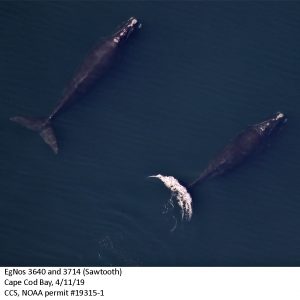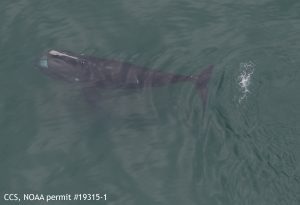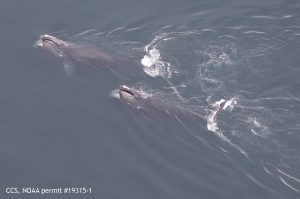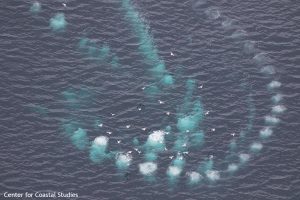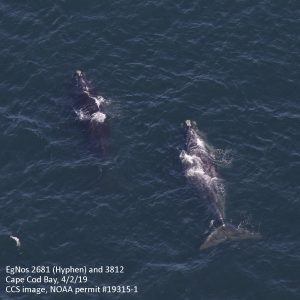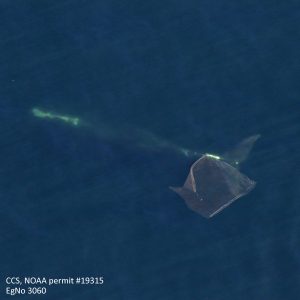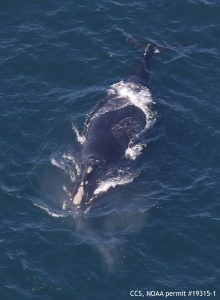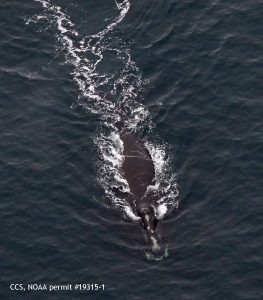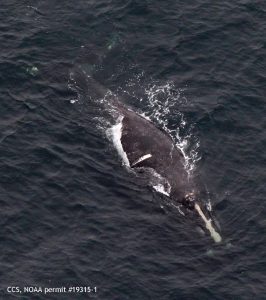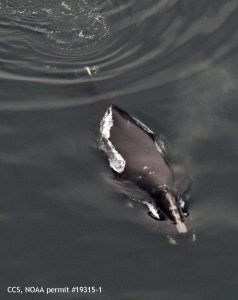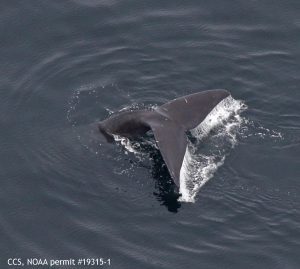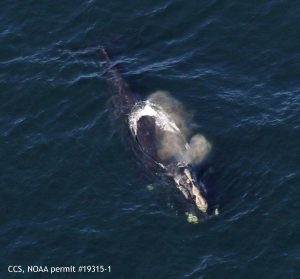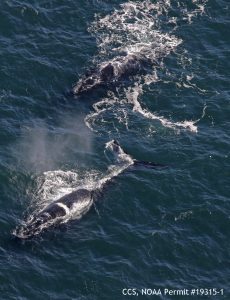Field Notes 2019
This was the final flight of the 2019 season. Zero right whales were observed during the survey.
May 7, 8, 9 & 11 2019
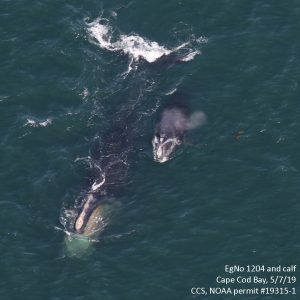
Right whale EgNo1204 and her calf subsurface feeding. Cape Cod Bay, 5/7/19. CCS, NOAA permit #19315-1
The end of the season is approaching and the aerial team has been busy over the past week. We flew Cape Cod Bay four out of five days (Tuesday, Wednesday, Thursday and Saturday), and also tacked on a Massachusetts Bay survey on Thursday afternoon. Over this period of time, we also seemed to have documented the right whales leaving Cape Cod Bay.
Tuesday’s flight was not in ideal conditions, but we were really trying to get a survey in to see if right whales were still present in the bay. It turns out that they were. We found 13 right whales including #1204 and her calf, many juvenile animals that we have been seeing consistently over the past few weeks, and #3617 “Salem,” an adult male who we have not seen in Cape Cod Bay in a month. With the high sea state, we likely missed a few animals, but we don’t think that it was a substantial amount.

Right whale EgNo 2503 (Boomerang) and spyhopping calf. Cape Cod Bay, 5/8/19. CCS image, NOAA permit #19315-1.
Wednesday had us flying Cape Cod Bay in much better conditions, and we found 11 right whales on this day. Interestingly, only two of these animals were the same, “Salem” and #3980 were seen on both surveys, but that left nine individuals we had not sighted the day before. “Boomerang” and her calf were in the bay today, but where were #1204 and her calf? It begs the question: did we miss all of these animals the previous day or was there a lot of movement?
On Thursday, we had great conditions again, but in all of the areas we had expected to find right whales, we found nothing. One lone right whale, #4080, was subsurface feeding in the middle of the bay, but that was it. We landed for fuel, but then kept flying north into Massachusetts Bay to see if there were any right whales up there. We did find one right whale, as well as many kick and bubble net feeding humpback whales, some sei whales, and a few fin whales. With this low number of right whales in Cape Cod Bay, the Massachusetts Division of Marine Fisheries lifted the fishing gear closure that had been in place to protect right whales in Cape Cod Bay from becoming entangled in line. We are hopeful that this really was the last of the right whales in Cape Cod Bay.
Saturday was a gorgeous day, so up we went again to see if there were any whales left in Cape Cod Bay. All was quiet, until the middle of Cape Cod Bay where we found a pair of right whales. Once we got closer, we realized that this was #1204 and her calf. When we got a better look at the calf, we realized that it had mud all over it’s head. It must have been rolling around on the bottom. With the lobster fishery back in place, we hope this mom and calf safely make their way out of the bay soon. We will be flying again soon to see if there are any more right whales around but also processing the rest of our data.
-Alison
Wednesday May 1 2019
The right whales are still out there! Ideal conditions of calm seas and grey skies limited the glare and made our job easier. We were once again able to complete two surveys today: we surveyed Cape Cod Bay in the morning, where we found 31 right whales, and in the afternoon we headed east of Cape Cod where we found many other species, but not a single right whale.
In Cape Cod Bay the whales were once again scattered along the western side and almost all of them were skim feeding. We found a large aggregation near Ellisville, where the whales were feeding in such shallow waters that we could see the bottom our photos. The shallow water highlighted the whales as they made their way back and forth along the patches of food.
One of these whales we recognized as #4146 (pictured). She is a young female born in 2011 that we encountered entangled in Cape Cod Bay back in 2017. She is doing well today, but still bears the scars from that entanglement.
Feeding alongside #4146 were an overwhelming majority of other juvenile whales. These included juvenile females #4520 and #4191 who were working a patch of food together as they followed one another around. These whales were so concentrated in their feeding patch that we were able to fully document 12 individuals in only six minutes!
Other sightings from Cape Cod Bay included mother calf pairs, #2503/Boomerang and #1204, as well as the first basking shark we have seen in the bay so far this year.
After a quick refuel in Chatham, we were back on track. The conditions remained excellent as we made our way up the eastern outer shore of Cape Cod. Although we didn’t find any right whales, we were kept busy by all of the other marine mammals out there.
We documented over 83 humpback whales, most of who were bubble net feeding. This behavior is spectacular to see from the plane since it’s possible to see the individual blowing the bubbles as well as the bubbles as they rise to the surface. We came across a humpback mom and calf and got great looks of the calf frolicking around waving its pectoral flippers around in the water (which it didn’t seem to have great control over yet).
Groups of skim feeding sei whales kept tricking us into thinking we had right whales; we would break track to investigate and each time be proven wrong. Some of the sei whales were also lunge feeding, as were many of the fin whales that we observed. We even found a feeding basking shark here as well. It seemed to be a feeding frenzy for everyone.
Often when we see the first basking sharks arrive as we did today, the right whales leave the bay shortly after. We are curious to get up and fly again soon to see how the right whale distribution might be changing.
-Alison
Monday 29 April 2019
After the somewhat surprising return of right whales in the bay last Thursday, we had not had a chance to survey again until now. We took off from Provincetown Municipal Airport to slightly high winds, knowing that they were forecast to calm down throughout the day.
Starting on our backside track (east of the Cape Cod shoreline) we headed south and found a variety of species: fin, minke, humpback whales, and one right whale. This individual was skim feeding next to a humpback, which made for a cool sighting, but even more interesting was that this whale has not been seen since 2014! She has been identified as #1612, and she was first observed in 1986 at an unknown age with a calf. She has since had four additional calves documented, with the most recent in 2013, and is mostly seen in the years she calves, while very sporadically other seasons.
We continued our survey into Cape Cod Bay starting in the south, where it was pretty quiet until we reached Ellisville. There we observed six feeding right whales within two miles from shore. This included a lobtailing right whale with a white chin and belly, #3120.
#3120 is an adult male born in 2001, and is an individual we have seen consistently since 2012. He, along with the other right whales in the west, were in close proximity to much shipping traffic heading to and from the Cape Cod Canal. There is currently a 10 knot speed limit for certain water of Cape Cod Bay to protect the whales from ship strikes, so hopefully there will not be any whale vessel interactions.
We continued on and found that although most of our right whale sightings were concentrated on the western portion of the bay all the way up to Duxbury, some were dispersed in the center as well.
Unfortunately, we saw a lot of debris during this flight including plastic, netting, and a plethora of balloons. And, yet again, we observed a right whale, the 2017 calf of Pediddle, barely avoiding a piece of plastic while feeding. We also documented a fair number of buoys inside the bay, which was unexpected since there is a gear closure in Cape Cod Bay annually from February through April. This is implemented to reduce injuries and mortalities of large whales due to entanglement.
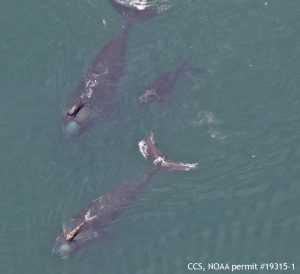
EgNo 2503 Boomerang and her calf, with EgNo 3760, Callosity Back. Cape Cod Bay, 5/1/19. CCS, NOAA permit #19315-1
On our final track line in the northern part of the bay we encountered a mom-calf pair that were on long dives with short surfacings and therefore difficult to work. Our 30 minutes of circling paid off because it was a new pair for us this season: #2503/Boomerang + calf!
This is the fourth out of seven mom-calf pairs that our team has seen in the northeast that were first documented this winter in the southeast. Boomerang was born in 1995, and has had four calves (including this one) that we know of. Our team last saw her in 2012, and overall she has not been seen frequently in Cape Cod Bay throughout her sightings history.
We will be surveying the bay again within the next week to document any shifts in numbers and distribution- hopefully weather improves and we can fly at least two full days.
– Brigid
25 April 2019
We finally got a break in weather after being grounded by high winds, fog, and rain since our flight last Wednesday. We were wheels up by 8:30 am and planned to try to have an ultimate day of surveying – fly a quick Cape Cod Bay survey, land just after midday to refuel, and then head up and fly the backside of the Outer Cape on our way back to Provincetown. It worked unexpectedly well on our last survey, when we had just a few sightings of whales in the bay and the longer daylight that these spring days bring. Alas, the whales a very different plan for us.
We started off in the north and had a few easy sightings of right whales feeding just below the surface. These whales were all distributed on the west side of the bay; a first for us this season. When we got to the fourth whale of the day, Alison (as photographer) immediately recognized it as #2310, an entangled whale first seen carrying gear south of Nantucket in December. We had a closer look to see if we could still see any rope; we did, but it was difficult to see and was only recognizable because we knew where to look.
Right whale #2310, an adult male at least 26 years old, is an occasional visitor to Cape Cod Bay. The last time the CCS team saw him was 2013; other colleagues had sighted him gear-free in adjacent waters in April 2018.
We alerted our disentanglement team, who quickly arrived on scene, then spent the next few hours circling above the whale so that we could help guide the movements of the MAER team. Documenting from the air ended up being critical since the rope on this whale is so difficult to see from the water.
Our need for fuel ended our time with #2310 and but we were happy and relieved to see that, even in his current predicament, he was very focused on feeding. In fact, he stayed working a patch of food the entire time we were with him.
When we got back in the air to continue our survey, we immediately found ourselves in a whale soup of minke, fin, sei, and humpback whales! We found 53 more right whales as well, including moms #1204 and #4180 with their calves. It was absolute feeding chaos! Unfortunately, many of the whales were right in the shipping lane coming from Cape Cod Canal, so we hope the food resource continues to swing around to limit the risk of ship strikes.
We finished our survey with a line up the east side of Cape Cod. It wasn’t quite the full offshore survey we planned for at the start of the day, but we were rewarded with 70+ humpbacks off of Chatham, most of which were bubble net feeding. It was well organized chaos! We wish we had the daylight to photograph them but we were racing the sun to get back and land in Provincetown.
We will be up again as soon as this next storm system breaks and in the meantime, we’ll be catching up on our sleep in between processing this latest batch of sightings.
At last count (prior to this flight) we had identified 250 individuals sighted by our team so far this year. Only time will tell how many more will come and how long they’ll stick around.
-Amy
17 April 2019
The right whale aerial team was quite busy on Wednesday, as conditions allow us to conduct two surveys around Cape Cod. We started in Cape Cod Bay, but found lower numbers of right whales than we expected. With the extra daylight, we decided to see what was happening on the eastern side of Cape Cod. It was very interesting to be able to cover so much area on a single survey day.
Cape Cod Bay was very quiet compared to our recent flights where we documented high numbers of right whales. We found a group of three right whales coordinated feeding close to Race Point, but that was followed by many track lines where we didn’t see any right whales at all. Finally, we saw some disturbance in the water and broke track to check it out. We were pretty sure there had been a whale, but couldn’t find one. We were patient and finally an animal came up but we were momentarily confused as to what it was. Turns out it was a right whale calf, but it was not next to its mother and it threw us off since it was “ultra tiny,” as our pilot stated. It’s not unusual for calves to start venturing off on their own at this age, but mom is usually close by. We waited a little longer and sure enough we found mom, EgNo 3317, who was right back next to the calf.
The remainder of the bay had a few more sightings of individual whales, but no aggregations. We found a couple of adult males, EgNo 1317 “Ergo” who we haven’t sighted in the bay for some time, as well as EgNo 1122 “Minnow”. Both of these whales were first documented in the 1980s and have been feeding in Cape Cod Bay for decades.
With only ten whales sighted in Cape Cod Bay, we finished our survey very quickly. After landing back in Chatham, we refueled both the plane and ourselves (we went on a quick burrito run), and got back into the Skymaster to survey the Eastern outer shore of Cape Cod. Conditions were excellent for this survey as well, and we found more right whales on this flight than we did inside the bay. Most of these animals were very spread out, but were all skim feeding.
We were excited to see some sei whales feeding near right whales, as well as a basking shark. We recognized the majority of the right whales from having previously been sighted in Cape Cod Bay this season, helping to explain where at least some of the whales in Cape Cod Bay had gone. Once we got to the very end of our survey, we spotted a whale skim feeding near Race Point. We diverted, and then found a line of ten skim feeding whales! Some of them we recognized from earlier in the day, but where had the rest been when we flew over in the morning?
Having surveyed both areas in the same day, we have a better picture of where the whales have gone now that there are fewer inside Cape Cod Bay. Although some were spotted on the Eastern shore, many are likely somewhere else nearby where there is better food. We are interested to see if the food will lead them back into Cape Cod Bay at a later date. Stay tuned!
-Alison
11 April 2019
We took off a little after noon because of high winds in the morning. Flying south to north, we had a quiet start in the southern portion of Cape Cod Bay until we reached our third track line of the day. Although conditions were great, right whales were mainly on long dives with short surfacings, and therefore were quite difficult to work.
We saw some old and new faces including two new mom/calf pairs for our team this season: #4180 + calf, and #3317 + calf.
EGNO 4180 was first seen in 2010 by our team, making her at least 9 years old, and we have seen her every year in Cape Cod Bay since except for 2015. The last time we saw her was in late April 2018 (little did we know she was pregnant), and unfortunately sometime between then and the summer she encountered gear and was seen with new entanglement wounds on her peduncle and back. She was first seen with her calf by a Florida park ranger from shore in February. Interestingly enough prior to this sighting her sex was unknown, and with her first calf it confirms she is a female. We saw EGNO 4180 and her calf in the southern portion of the bay.
EGNO 3317 was born in late 2002 (16 years old) to EGNO 1817/Silt, who was also sighted in Cape Cod Bay this season. Silt brought her into Cape Cod Bay when she was a calf in 2003, but our team did not see her in the bay again until 2016, which happens to be the last time she had a calf. Her first calf was in 2009, EGNO 3917, and even though she did not bring her to Cape Cod Bay EGNO 3917 has been observed here nearly annually, including this year, since 2011. In 2017 we documented EGNO 3317 outside of Cape Cod Bay, and last year (when she was pregnant) we saw her inside the bay between February and March. She was the second mom documented this season, and like EGNO 4180, was first documented with her calf from a shore sighting in January. We saw EGNO 3317 subsurface feeding, with her calf, in the middle part of the bay.
We observed a SAG with #3230/Infinity as the focal female, and another low energy group of adult female #2040/Naevus and adult male #3714/Sawtooth. Naevus was born in 1990, to #1140/Wart, and brought to Cape Cod Bay as a calf. She was not sighted in the bay until a decade later (2000), nor again seen in Cape Cod Bay for another 10 years after that (2010). Sawtooth was born in 2007, to #2614/Tripelago, and is named for the unique trailing edge of his fluke. Our team has seen him nearly annually since 2011.
Because of daylight restrictions we only finished six track lines, including our backside track on the way back to the airport. There we were surprised to find over ten right whales skim feeding with sei whales, but couldn’t spend much time because sunset was so close.
We are looking forward to better weather and getting back up in the air again to see how the number and distribution of right whales has changed, if at all.
– Brigid
2, 6, and 7 April 2019
Spring has not been kind to our aerial surveys – our weather windows have been few and far between, not to mention short, so we have not been able to complete our survey in full for quite some time.
We had hopes of flying all of the track lines of our Cape Cod Bay survey on 02 April, even though we had to take off later than in the day to allow winds to calm down, but unfortunately conditions worsened and cut our flight short without flying the southern portion of the bay. Even so, we documented nearly thirty right whales, including some of the following new individuals of the season: adult female #3760, Callosity Back, adult male #2681, Hyphen with adult female #3812, the 2017 calf of 1711 (who was brought to the bay as a calf), and adult male #1271, Dropcloth. Dropcloth is an adult male first seen in 1978, who we have seen in Cape Cod Bay nearly annually since 2011.
On Saturday 06 April the weather looked promising for us to fly our eastern outer shore tracks. This survey can be enlightening given we have had so many individual right whales in the area with high turnover, so we could possibly capture them entering and/or leaving Cape Cod Bay during this flight.
On our transit north we opportunistically encountered 8 right whales in the bay, and documented them prior to continuing onto our dedicated survey. Unfortunately, fog was on the horizon and though it subsided for the northern tracks the survey had to be ended early because of poor visibility in the east and south. Other species seen include sei whales, minke whales, Atlantic white sided and common dolphins, and seals. We also saw more anthropogenic marine debris including a bundle of over 20 balloons and plastic netting, which is unfortunately more of a common occurrence as of late.
And then came Sunday 07 April. A beautiful day to start, a little rougher to finish, and in the end over 150 right whales documented. Behaviors ranged from subsurface feeding to deep diving to surface active groups (SAGs).
This day marked not only the most individual right whales sighted for the season thus far, but also our first mom calf pair in 2019! The mom is #1204, an adult female who was first seen in 1982 at an unknown age, making her at least 38 years old. This is her ninth known calf with her first documented calf being in 1988, and most recent prior to this year’s in 2013. #1204 was subsurface feeding and both she and the calf look great. For more information and photos read our press release. There are seven known moms this season and we are hoping to see the other six if they choose to come to Cape Cod Bay.
Another interesting sighting from this day was of three whale SAG involving adult female #1719, and adult males #3680, Sea Dragon and #2750, Haley; all three are new for us this season. We are still in the process of identifying individuals but recognized another new one: G055, who was subsurface feeding with #3060. This intermatch code is given when a whale is seen more than once but we are unable to match it to a cataloged whale. Usually it is a young whale who has not been assigned a four digit ID yet. In this case both us and another aerial team have sighted it and we look forward to finding out who it is in the future.
Not including Sunday’s flight we have identified 186 individual right whales (~45% of the population), and expect once photo analysis is caught up we will have broken 200. April showers are in the forecast but hopefully we will get another flight in later this week.
– Brigid

EgNos 1719, 3680 (Sea Dragon), and 2750 (Haley) coordinated subsurface Feeding. Cape Cod Bay, 4/7/19. CCS, NOAA 19315-1
27 March 2019

EgNo 1249, Lacrosse. Cape Cod Bay, March 27, 2019. CCS image, NOAA permit #19315-1.
Our only weather window this week shaped up to be on Wednesday the 27th of March. Having no idea what happened since we flew a week ago, we knew we needed to cover the bay again. In recent years, we’ve peaked with right whale presence in the bay around this time. Unfortunately, the winds didn’t start dying down until late morning so we had a bit of a later start. Knowing full well we wouldn’t finish a survey unless whales were skimming and easy to work, we set out to cover as much as we could. Finishing near Wellfleet due to fading daylight, we didn’t get a chance to document the loads of whales we could see in the southernmost of the bay. However, we still documented nearly 85 individuals by day’s end.
Our first four lines were quiet, with only a fin whale sighting northeast of Provincetown. Our first couple of right whale sightings were of non-feeding animals. A jumble of new and familiar faces from this season kept us on our toes and set the scene for what we would find the rest of the survey. About half of the whales were subsurface feeding in the upper part of the water column – exhibiting that risky behavior that makes them undetectable to mariners but still within striking range. The rest were either travelling, or diving and surfacing with mud on them – likely feeding on a resource on the bottom.
We were able to document one of two observed surface active groups (SAG). In the first half of our survey, we had a SAG featuring Echo (#2642), a sexually mature female. Echo was born in 1996, her mother is Kleenex (#1142). Kleenex is currently entangled and an effort to disentangle her was mounted by CCS’ own MAER team nearly a year ago. Since then, sightings by other colleagues have shown her to be still entangled and her condition deteriorating. It’s unknown if she’ll survive her entanglement but based on what we saw yesterday, we have hope that her genes will continue to be passed along through her progeny, like Echo.

EgNo 2642, Echo, in a Surface Active Group (SAG). Cape Cod Bay, March 27, 2019. CCS image, NOAA permit #19315-1.
Five individuals are estimated to be in the SAG. Sometimes, after we finish fully processing the photographs, a body part that doesn’t belong to any of the known animals is found – so there’s always the possibility that the number of participants grows! When we happened upon the group, we saw Echo belly up, a whale next to her stroking her. Soon everyone was at the surface and at least one lucky male successfully copulated with her!
Right whales employ a reproduction strategy that leads to sperm competition between males. With many males attending to a focal female, they jockey for position that places them directly next to the female (in order to have successful intromission). Since physical size and successful sperm delivery helps a male beat out his competitors, this strategy goes a long way to explaining why right whales have the biggest testes of any animal – weighting nearly 1 tonne!
After trying our best to fully photograph all participants, we left the group to continue our survey. We found out later from our CCS crew on R/V Ibis that Echo concluded her energetic afternoon with a feeding bout in Provincetown Harbor. We’re all hoping she finds the calories she needs and hoping she’ll be sighted in the calving ground with a brand new calf next season! One can hope…
-Amy
19 & 20 March 2019
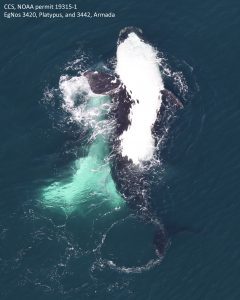
Right whales EgNo 3420, Platypus, and EgNo 3442, Armada, in a SAG. Cape Cod Bay, March 20, 2019. CCS image, NOAA permit #19315-1.
The weather window looked decent this week with Monday through Thursday as potential survey days. We decided to fly the bay Tuesday, the 19th, south to north since the forecast was so promising. It was wrong. The crew found that the sea state and swell were not even close to what were predicted, and the survey conditions quickly deteriorated to the point that the flight was ended after only flying five track lines. Despite the high sea state and short flight, the team was able to document twenty-nine right whales in the southern portion of Cape Cod Bay, including at least two new individuals for the season.
We tried again on Wednesday, the 20th, north to south with hopes of better sea states and were quite pleased to what we found. The sea state ranged from 1 to 3 on our first leg but unfortunately after we refueled conditions worsened so we ended the flight early with only track lines 1-13 and 16 completed. We not only sighted sixty-eight right whales but also two humpbacks and two fin whales. The right whales were semi-concentrated in the middle of the bay, however, we sighted a single individual very close to Herring Cove who may have been visible from shore.
We saw some familiar faces but also some new whales for the season including: adult male EgNo 1227, Sliver, juvenile male EgNo 414o, Casper, adult male EgNo 3380, Lemur, adult female EgNo 2360, Derecha, and two in a SAG with EgNo 3420, Platypus: adult males EgNo 2303 and 3442, Armada. It was one of the more high energy SAGs we have seen this season and all involved had white chins and bellies, which were visible subsurface and created quite a show.
Unfortunately, we also documented a lot of marine debris as well: plastic, balloons, netting. One distinct red mylar balloon was sighted by R/V Shearwater in the air over Cape Cod Bay on Tuesday and we documented the same one in the water on Wednesday. We also observed two right whales, EgNo 3060 and Lemur, near some marine debris and were relieved when 3060 avoided it in its path.
We are hoping to see a mom-calf visit the bay soon and are looking forward to next week when weather looks good enough to fly. Until then we will be busy processing all of the data and images from our last three flights and preparing for our next survey.
– Brigid
March 13, 2019

Coordinated feeding by EgNo 3860 Bocce and EgNo 3420 Platypus. Cape Cod Bay, 3/13/19. CCS image, NOAA permit #19315-1.
On this flight we were able to complete a whole survey of Cape Cod Bay from north to south. We took off from Provincetown as early as the pilots could accommodate, allowing us 9 hours of survey-able daylight with time to land to refuel.
The survey started out great. Not sure of what we would find, our first couple of sightings yielded a surprising (and welcome!) change in behavior – we could see animals feeding below the surface! Whilst still out of photographing range, we could at least keep track of them while we waited for them to surface.
First up we sighted EgNo 3860, Bocce, a mom from the 2016 season, and a new individual for this season. Shortly thereafter we had Herb and Clipper, both of whom were sighted on previous surveys this season. On our next track we broke again for Bocce who was this time coordinating her feeding with a familiar face, EgNo 3420, Playtpus (pictured)! We hadn’t sighted Platypus for a number of surveys and we weren’t sure if she had moved on to bluer pastures or if she could be included in our many counted-but-not-photographed right whales on the last few surveys. We can’t say just yet if she left and came back but we’ll continue to call the bay her home base for the last four months. It will be interesting to see how long she sticks around these parts.
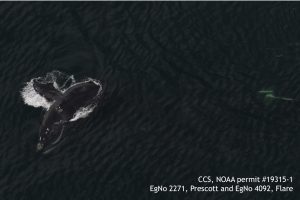
EgNo 4092, Flare (right, underwater) and EgNo 2271 Prescott in a SAG. All that can be seen of Flare are the white scars on her peduncle. Cape Cod Bay, 3/13/19. CCS image, NOAA permit #19315-1.
For the rest of the flight, as the winds and seas died out to near perfect conditions, we had scattered sightings in the middle of the bay, nothing close enough to be visible from shore. We landed to refuel and stretch our legs in Chatham and didn’t expect too much more activity for our final four track lines of the survey. Boy, were we wrong! We got crushed with right whale sightings in the south part of Cape Cod Bay, many just 1.5-2 miles away from Sandy Neck in Barnstable. We notified R/V Shearwater of the large aggregation and they were able to come and sample the prey resource near many of these whales.
We still had a mix of deep diving and subsurface feeding in the south, and we also found EgNo 4092, Flare and EgNo 2271 Prescott in a SAG! We even noticed whales starting to skim feed late in the day near our research vessel, so it’s only a matter of time until zooplankton is high enough in the water column to warrant skim feeding by the majority of right whales. As it is now, these animals are starting to be at a higher risk for vessel strikes while they remain shallow but undetectable by boaters.
Brigid is still processing her photos, but we know we are up to at least 118 individuals sighted so far this season. Of those, the majority have been adults, with only 11 juveniles or unknown age class being sighted. We still have a male majority in the bay where 66 are known to be males, 44 known females. However, we know there’s now a male bias in the population due to decreased survival rates of females that have been documented by colleagues. We were surprised to see that our sex ratio of individuals sighted in CCB matches the overall population estimate bias! It remains to be seen if we’ll see a mom/calf pair this year, but we’re holding out hope we find one in the next couple of weeks.
-Amy
March 9, 2019

EgNos 3232 (adult female, Lobster) and 3989 (adult male) in a SAG. Cape Cod Bay, 3/9/19. CCS image, NOAA permit 19315-1
We took off from Provincetown Municipal Airport around 08:30 to slightly lumpy seas. We flew south to north, so our first track was line 16, which runs parallel to the Cape’s eastern shore. We have not sighted a right whale on the back side this season- until now. Barely 10 minutes into the survey a right whale was seen about 2 miles east of Lecount Hollow Beach in Wellfleet. This individual was new for our season: Sagamore (#1934), an adult female born in 1989, and who has not been documented with a calf in her 30 year life span. She is a semi-frequent visitor to Cape Cod Bay and we last saw her in 2017. She was heading north so we are looking forward to see if she will come into the bay or not.
After we finished circling Sagamore we finished that line and then began our tracks in the bay. We sighted our next right whales shortly after, about 3 miles north of Sandy Neck, and were busy for the remainder of the survey.
We saw a wide swath of right whale behavior, which added to the day’s excitement: a surface active group (SAG) between adult female Lobster (#3232) and adult male #3989, a breach fest by adult male #3298, adult male #2904 feeding, and defecation by two individuals. Defecation demonstrates that the whales have been recently feeding, which is what we suspect based on dive patterns and plankton samples but still great to have confirmed.
One of the individuals observed defecating was none other than Calvin (#2223). Calvin is an adult female born in 1992 to Delilah. You may be familiar with Delilah because she is the whale from which the Center’s life size inflatable right whale is named after. Deliliah died after being struck by a ship in Bay of Fundy when Calvin was only about 8 months old, leaving her survival uncertain because of her young age at weaning. Fortunately, Calvin was resighted the following year, much to the delight of the right whale community. Despite having been entangled in gear at least twice in her 27 years of life she has been able to successfully give birth to at least three calves.
We documented 54 right whales in all, leaving a fair amount unphotographed because of short surfacings and long dives. We landed for the day around 16:15, and will be busy the next few days in the office matching the photographed individuals and preparing for our next flight.
March 5, 2019
We weren’t expecting to get a weather window to survey again until Saturday, so on Monday afternoon when some forecasts were reporting flyable weather on Tuesday, we prepared to be on standby for today. Waking up on Tuesday, we watched the current weather being reported around the bay until the wind came down enough to warrant us going out. The pilots scrambled out of Plymouth, hopped across to Provincetown to pick us up, and we were on our way. We were shocked at how nice the water looked when we got away from the Race Point rips and had our fingers crossed we’d find whales.
We had planned to cover at least the northern most six tracklines to account for those missed on Sunday and it was all pretty quiet until we got to trackline five, similar to where we found whales last Friday. They displayed all the same behaviors we’ve been seeing for a month now, long dives with only a few breaths at the surface. Luckily, we had Christy making a guest appearance in our observer rotation and she was quick on the draw for taking photos.
We ended up documenting at least 36 whales on the 12 track lines we covered. We had cut the survey short just after 3 pm, as expected, when turbulence and sea state increased.
Luckily we found a few new faces which are likely part of the whales left unphotographed from the surveys this weekend. Of those new notable faces we found Butterfly (#1425) and Prescott (#2271)!
Prescott was especially exciting because we’ve been waiting to see how his lump on his left flank is progressing. A regular visitor to CCB, we’ve been tracking the progress of his suspected abscess since we first noticed it in 2016. As seen in the photos, it looks like it likely opened again at some point, the white scarring more noticeable when compared to photos taken last year. So noticeable in fact that Christy, more familiar with identifying plankton than individual right whales, knew who it was within seconds of photographing him!
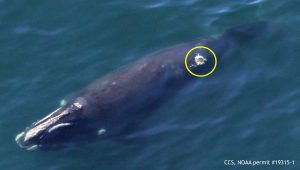
Right whale EgNo 2271, Prescott. The white scarring from his suspected abscess is circled. Cape Cod Bay, 3/5/19. CCS image, NOAA permit #19315-1.
We also had a resights of Manta (#1507), Mantis (#1620) and Aphrodite (#1701). With our photos processed through Friday’s flight, we’re up to 66 individuals already sighted in Cape Cod Bay this season. And we know that number will grow once our photos from Sunday and today are finished being processed. We are hoping to fly again on Saturday but we’ll see what the weather hands us.
-Amy
March 1 & 3, 2019
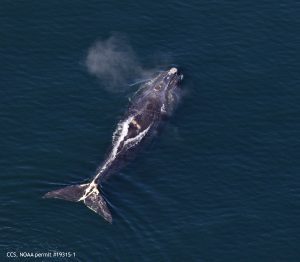
Right whale EgNo 1971, Nantucket, displaying scars from a severe entanglement in fishing gear. Cape Cod Bay, 3/1/2019. CCS image, NOAA permit #19315-1.
It was a busy weekend for the right whale department thanks to some fantastic weather. On Friday, March 1st, both the aerial and vessel teams were able to get out and survey. The aerial team documented 46 individuals in the Bay, while the vessel team traveled below to hopefully get an idea of what these whales are feeding on, and obtain vessel based photos of the right whales in the bay.
On Sunday, the aerial team got a late start as we were waiting for ice to thaw on the runways, but we still documented 45 right whales in Cape Cod Bay, even on this partial survey!
Conditions were very calm on both survey days, but that didn’t mean that our work was easy. The whales in Cape Cod Bay are likely feeding on the bottom, doing long dives and spending little time on the surface. So yes, it was very easy to see the whales when they were at the surface, but they had usually gone down for a dive by the time we were ready to photograph them.
Most often, when we were waiting for individuals to surface, more whales would come up at some distance away and we had to prioritize who was going to be photographed and when. We ended up zooming around all over the place trying to efficiently document whales that were close by, while leaving others that were at a distance for later. The survey tracks from both days look like a spaghetti dinner.
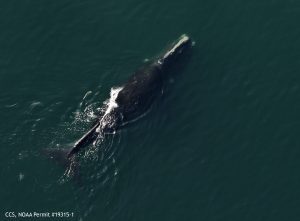
Right whale EgNo Mogul, documented in Iceland this summer. Cape Cod Bay, 3/1/2019. CCS image, NOAA permit #19315-1.
Comparing the two aerial survey days, we notice that while some whales were photographed on both days, many individuals were photographed on only one. We don’t believe that there is that much exchange in and out of the bay, but rather the whales are on such long dives that we are missing a lot of them on our surveys. There must be a lot of whales in Cape Cod Bay!
We were excited to find some new individuals for the season including three adult males, Nantucket EgNo 1971, Mogul EgNo 3845, and Gemini EgNo 1150.
Nantucket (pictured) is recovering from a severe entanglement in fishing gear. We haven’t seen him on our surveys since the entanglement, and were able to document the wounds for monitoring.
Mogul was the right whale that made the news this summer having been documented in Iceland! Welcome back, Mogul!

Right whale EgNo 1150, Gemini, has been coming to Cape Cod Bay since the 1980s. Cape Cod Bay, 3/1/2019. CCS image, NOAA permit #19315-1.
Gemini, was first documented in 1979, and has been coming to Cape Cod Bay at least since the 1980s, he is still often sighted in the Bay. For our followers, we also had re-sights of Ruffian EgNo 3530 & Legato EgNo 1802 and new for the season were Sparky EgNo 1801, and Herb EgNo 1250.
It’s great to see so many whales feeding in the Bay, but we will admit we are looking forward to when the food and therefore the whales rise towards the surface. We are still spinning from all of the time spent circling waiting for the whales to come up and breathe.
– Alison
20 February 2018
We surveyed Cape Cod Bay on Wednesday, flying north to south. Anticipation was at fever pitch because it had been two whole weeks since we were able to fly. The boat was out deploying acoustic buoys in the Bay on Sunday and we knew from the couple right whale sightings over the weekend that their behavior was consistent with what we saw on our flight two weeks ago. Right whales were still in the bay but going on deep dives.
With the animals being down for long periods of time, documenting them for the short time they are at the surface can be tricky. Couple that with our shorter day light this time of year, we have to choose how much time we’re going to devote to circling to re-sight an individual.
We took some extra time on the ground to work out a few logistics. This was our first flight in a couple of years where our primary pilot, Trevor, was not in the plane with us. We flew with Craig and Bob, two pilots that we have flown with on a regular basis but whom have never actually flown with each other. We, as observers, had to set their expectations to be the worst – lots of long dives necessitating a long time circling. Luckily, these two are consummate professionals and ready and willing to help us achieve our goals of finding, and photographing the maximum amount of right whales in a short period of time.
After taking off out of Provincetown, we had a quiet first couple of track lines, mostly just spotting a lot of vessel traffic. About a third of the way through the survey, we had our first blow. Unfortunately, by the time we made it over, the whale dove and we settled in to circle. While waiting for this animal we ended up finding three other whales nearby. We widened our circles to photograph those sighted on circle and found two females we have already seen in the Bay so far this season, #1706 and #4190. When the whale we first broke track for finally came up, it was with another whale, bringing our sighting total to 5. If we had missed the blow first seen from track, we would have passed right by these 5 animals!
We ended up finding a clump of whales in the middle part of the bay and another, wider spread aggregation to the south west side. Of these animals, 9 were whales already observed this season, and 16 were new. We had to leave 9 whales unphotographed as we were running out of daylight and fuel so who they were will remain a mystery.
Some of the notable new whales we had on Wednesday were Comet (#1514), Lobster (#3232), Ergo (#1317).
Comet, named for the scar on his back that looks like a comet flying through space, is an old male, first seen in 1985 by CCS in Cape Cod Bay. His exact age is unknown because he wasn’t seen as a calf. Lobster, newly named this past November, is a 17 yr old female. Her official name came from the nickname we gave her in when we were seeing her regularly the last three years. We called her ”lobster” because her callosity pattern in her bonnet looks like a lobster with two claws hanging on either side. Luckily, other members of the consortium voting on names could see it in the pattern too. Ergo is named for the three scars on his right shoulder that form a triangle. The formation is similar to the mathematical symbol that means “therefore,” or as one would say in Latin “ergo”. Ergo was first seen in Cape Cod Bay as a calf in 1983, making him 36 years old!
-Amy
6 February 2019
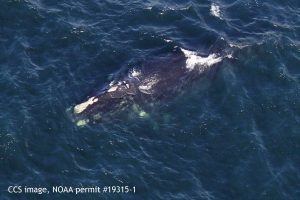
Female right whale EgNo 1802, Legato, photographed in Cape Cod Bay on 2/6/19. CCS image, NOAA permit #19315-1
On Wednesday, February 6th, we took off from Provincetown around 10:30 AM to allow winds to come down a bit as forecasted. Since we were flying from north to south with northerly winds, the first lines sea state and swell were quite high. However, the sea state improved throughout the day. All was quiet until track line 9, when we encountered our first blow in the western middle of Cape Cod Bay.
One blow led us to document five individual right whales who all were doing long dives. These sightings felt more like a “whack-a-mole” scenario; one whale going down to never be found again, but another coming up nearby. Having whales at the surface for a very limited time meant we had to circle for 30 minutes to try and re-sight them after they surfaced again. While circling in place can be frustrating, we know we found the other individuals only because we did stick around.
We continued on our survey and a couple of track lines southeast of the first aggregation we encountered another (difficult) group of eight right whales. It was a similar event where we broke for one whale and then discovered the others. After this we had another sighting of two right whales feeding, and then continued on until finishing around 4:00 PM. There was a quick turnaround as we had an encore presentation of our winter lecture at Napi’s Restaurant and even though it was a long day for the team it was a great one.
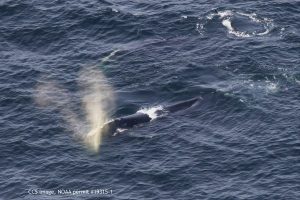
A beautiful heart-shaped blow from adult male right whale EgNo 3060. Cape Cod Bay, 2/6/19. CCS image, NOAA permit #19315-1.
From preliminary matching we found that the whales were a combination of old and new for the season: adult female EgNo 3420 Platypus and adult males EgNo 2920 and EgNo 3617 Salem have already been documented by us in Cape Cod Bay this year. New ones included three adult females: EgNo 1701 Aphrodite, EgNo 1802 Legato, EgNo 1706; an adult male: EgNo 3060; and juvenile female EgNo 4308.
Unfortunately, we only photographed 13 of the 15 whales because we couldn’t re-sight two of them. However, we felt lucky that we were able to document as many as we did, given their behavior. Weather this time of year is always tricky and we’re looking to the weekend or early next week for our next flight.
-Brigid
3 February 2019
The team has a running joke that if it’s a weekend with plans or a holiday, we are guaranteed to fly. While many in the country don’t observe Super Bowl Sunday as a holiday, it is one here in Pats Nation – so of course we flew.
All joking aside, we got a weather window we all dream of in February. Flat seas, little to no wind, and overcast skies (no bright glare!). Taking off slightly before 9:30, we worked our way north to south. It was a pretty quiet flight for the first half of the survey. Not many vessels, gear or marine mammals to be found. In the plane, we kept remarking how perfect the conditions were and how likely we were to find something IF anything came to the surface.
We got lucky right at the beginning of track 7. With a quick view of a body at the surface, we made it over to Harmony, just before she dove. A couple track lines after, we saw just a swish of water disturbance. We broke track to check it out and found Manta (pictured below) just before he dove and we were in position to photograph. Knowing we were going to hang out for a little bit, we kept our eyes peeled and ended up finding 3 other whales near him. Of these other three animals were Mantis, Tripelago’s 2017 calf, and Salem.
Moving on, we found a few more familiar faces including Arpeggio, 3823 and 2910. Funnily enough, most whales seemed to be favoring the east side of the bay but we kept finding them in a diagonal line running NE to SW. It’s likely we missed some whales since all individuals kept doing deep dives and we never saw them as we flew passed them on subsequent track lines. As such, we’re keen to get back in the air to fly again and see if we have the same animals or a whole other subset of whales.
Altogether, that brings our count up to 22 individuals sighted so far this season!

Right whale EgNo1507, Manta, photographed in Cape Cod Bay on 2/3/19. CCS image, NOAA permit #19315-1
January 26, 2019
The winds subsided and we were able to get up in the air and have a look around. It had been almost two weeks since our last flight and we were very curious to see what we might find. On our last flight (January 13), Cape Cod Bay had been eerily quiet with zero animals of any species seen! Conditions were a little challenging on that flight, but we were still surprised by the lack of marine life.
Today was thankfully much different, we had fantastic spotting conditions and were able to document five North Atlantic right whales as well as a number of dolphins on our flight.
We spotted our first right whale quite near the plane and could see the animal’s entire body under the water. It surfaced a couple of times, then raised its flukes in a deep dive likely returning to the bottom to feed. More v-shaped blows alerted us to several other individual right whales, as well as a surface active group (SAG) as the survey went on.
We were excited to identify the two individual right whales as EgNo 3617, Salem, and EgNo 1121, Fiddle. These are both mature males that often return to Cape Cod Bay to feed in the winter. It is the first time that we have seen either of these individuals so far this year.
Salem was born in 2006 to EgNo 1817 Silt who is also often seen in Cape Cod Bay. Salem has returned to Cape Cod Bay almost every year since his birth. Fiddle, gets his name from the callosity pattern on the top of his head which really does resemble a fiddle. Have a look at our photos! He was first sighted in 1981 has been frequenting Cape Cod Bay a lot more in later years, although he has been documented here off and on for many years.
The two animals in the SAG were easy to spot as they were rolling around at the surface and creating quite a lot of white water.
It’s sometimes tricky to document SAGs since the whales don’t always show their callosities (the main area we use to identify them) above the water right away. Instead we see flippers, tails, bellies, backs and chins and it just takes a little patience while we wait for the animals to raise the heads above the water.
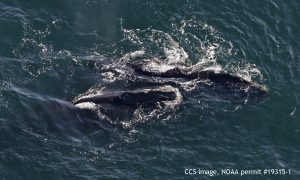
EgNos 3420, Platypus, and 1627, Wavy Gravy, photographed in Cape Cod Bay on 1/26/19. CCS image, NOAA permit #19315-1
We got great photos once they did and we were able to identify these animals as Wavy Gravy (EgNo 1627) and Platypus (EgNo 3420). This was our first sighting of Wavy Gravy for the season, but it would appear that Platypus has been in Cape Cod Bay for quite some time. We first documented her back on December 11 while we were out on the RV Shearwater, and saw her on December 14 and 30 as well. Has Platypus been in Cape Cod Bay the entire time?
The changeover of individuals in particularly interesting to us and we are curious to see if we will document Platypus on our upcoming surveys. Stay tuned!
-Alison
December 2018

EgNos 2753, Arpeggio and EgNo 2480. Cape Cod Bay, DEcember 11, 2018. CCS image, NOAA permit 19315-01
The CCS aerial team is officially back, and we’re flying earlier than usual this season doing some exploratory surveys. We documented our first right whales of the 2019 season on Tuesday December 11 in Cape Cod Bay. On this flight we flew from north to south and encountered our first right whale feeding slightly west of Great Island: an adult female (EgNo 3780). From there we continued on our survey and sighted 6 more right whales about 3 ½ miles north of Sandy Neck. Nearly all of these were also feeding, and were identified as adult males EgNos 1403, Meridian; 2480; 2602, Marble, 2910, adult female EgNo 2753, Arpeggio, and juvenile female EgNo 4190.
We flew north of the bay on Thursday December 13, and then the eastern shore of Cape Cod on Friday December 14. We did not observe any right whales in those areas, however, on our transit back to Provincetown we sighted a group of two right whales in Cape Cod Bay on Friday. These have been identified as adult female EgNo 3420, Platypus and juvenile female EgNo 4310. Our total number of right whales in Cape Cod Bay is up to 11 since two additional ones were seen by our research vessel, Shearwater: an adult male EgNo 2713 and a yet to be identified individual.
On Wednesday December 19 we surveyed Cape Cod Bay and found right whales again off of Great Island! Sea state and whale behavior weren’t conducive to getting ah-mazing photos (it was a beaufort 4 and they were surfacing for short periods before long dives), however, we were able to document 8 individuals including 3 new right whales for the 2019 season: 4092, Flare, 1820, Cello, and a staff favorite 3530, Ruffian. You may remember Ruffian for his appearance in 2017, after being disentangled in the southeast, and his return this past season. His body condition is good and he seems to be recovering so far from that 2017 event, which is great news!
Poor weather is forecast for this weekend but we are looking forward to hopefully completing 1 more flight before officially welcoming 2019!
- Brigid

Our Work
Humpback Whale Research
Right Whale Research
Marine Animal Entanglement Response
Marine Geology Department
Water Quality Monitoring Program
Marine Fisheries Research
Seal Research
Shark Research
Marine Education
Interdisciplinary
Marine Debris and Plastics Program
Marine Policy Initiative
Cape Cod Climate Change Collaborative
Publications

